
| Version | Summary | Created by | Modification | Content Size | Created at | Operation |
|---|---|---|---|---|---|---|
| 1 | Alessandra Neri | + 1341 word(s) | 1341 | 2021-04-14 03:54:00 | | | |
| 2 | Bruce Ren | -21 word(s) | 1320 | 2021-04-16 02:52:11 | | | | |
| 3 | Bruce Ren | -10 word(s) | 1310 | 2021-04-20 05:36:36 | | |
Video Upload Options
The enabling role of Digital Technologies towards the Circular Economy transition has been recognized. Nonetheless, to support the transition, the operationalization of the discourse is still needed. The present study performs a systematic literature review, deepening the knowledge on the role of Digital Technologies in operationalizing the Circular Economy transition. The analysis is shaped according to the ReSOLVE framework, as it has been recognized as able to operationally guide industrial firms towards the Circular Economy transition. Despite the broad focus on the topic by the extant literature, the results of the analysis show limited Circular Economy aspects addressed and specific technologies considered, making it difficult to have a complete overview on the implementation of Digital Technologies in the Circular Economy transition, operatively addressing it. Shortcomings are identified regarding the lack of an integrated and holistic analysis of the relationships, the need for investigating the decision-making process and specific Circular Economy practices, all from an empirical perspective
1. Introduction
Deep and rapid economic, environmental and social changes are taking place, shaping the political, managerial and academic discourses [1][2]. The industry is not exempt from these current macro-trends and opportunities arise for two specific paradigms, namely Circular Economy (CE) and Industry 4.0 (I4.0) [3][4].
CE focuses on closing the material loop, shifting from a linear economy to a circular one, decreasing material extraction, waste disposal and, consequently, environmental pressure [5][6]. CE can be applied at different levels, namely micro (single firm, from a single product to the advertisement), meso (industrial systems and networks) and macro (society or country) [6]. Although focusing more on an environmental perspective, it is impossible to separate CE from the economy and society, which links CE to the concept of strong sustainability [7][8]. On the other hand, I4.0 enables intelligent factories and products, providing opportunities for enhanced performance in terms of production activities, organizational strategies, business models and skills [9][10]. A central role in I4.0 is played by Digital Technologies (DTs) [11].
The two concepts have been largely addressed in a separate manner; nonetheless, in the last years, they started being integrated [12]. From a general perspective, it is widely accepted that DTs can enable the CE transition [13]. DTs indeed allow more efficient and flexible processes [14], while also providing transparent access to product data and resource consumption [13]. Despite the growing interest in the role of DTs as an enabler for CE transition, some points remain still not properly addressed. Particularly, focusing on the CE micro level, the need for making the overall discourse more operational, addressing the different phases of the CE transition [15], has been underlined [16]. The Regenerate, Share, Optimize, Loop, Virtualize, Exchange (ReSOLVE) framework has been identified as an important tool to operationally guide industrial firms [17]; despite its relevance, only a few studies so far have focused on the enabling role of DTs in the context of the ReSOLVE framework. The majority of the contributions, indeed, still focus only on specific CE aspects, such as recycling or resource efficiency. On the other hand, contributions focusing on the ReSOLVE consider the role of very few and specific DTs. Both situations underlined the lack of an overall, comprehensive and integrated approach towards the investigation of the role of DTs as an enabler for CE.
2. Digital Technologies Enabling the CE Transition: Descriptive Analysis of Results
2.1. Analysis of General Information
The temporal distribution of the contributions shows a more than linear growth, with 85% of them (n = 53) published from 2019 on, highlighting an increasing interest (Figure 1).
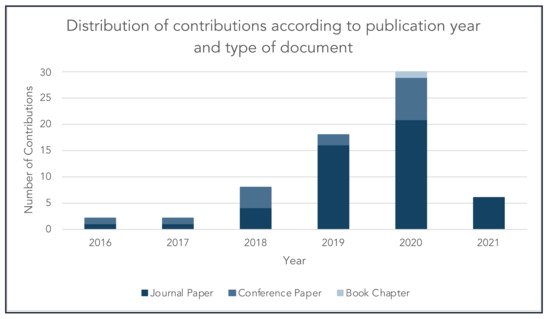
Figure 1. Distribution of the reviewed contributions according to publication year and type of document.
Considering the journal papers, the most recurrent Journals are Sustainability (Switzerland) (n = 7) and Resources, Conservations and Recycling (n = 6). The distribution shows how the topic has been mainly addressed by sources at the intersection of management- and environment-related areas (Figure 2).

Figure 2. Distribution of the reviewed contributions according to the most frequent journals.
In terms of authorship, 188 different authors were identified; 82% of the authors (n = 154) participated in the discourse with 1 contribution, and 16% (n = 30) with 2 contributions. Nine authors contributed with 3 (Bag S.; Nobre G.C.; Okorie O.; Rajput S.; Singh S.P.; Tavares E.; Tiwari A.) or 5 contributions (Charnley F. Moreno M.) (Figure 3). The affiliations were in the United Kingdom (Charnley F., Moreno M. and Okorie O, Cranfield University until 2019, then University of Exeter; Okorie O. University of Sheffield until 2019, then University of Exeter), South Africa (Bag. S., University of Johannesburg), India (Rajput S. and Singh S.P., Indian Institute of Technology) and Brazil (Nobre G.C.; Tavares E., Federal University of Rio De Janeiro).
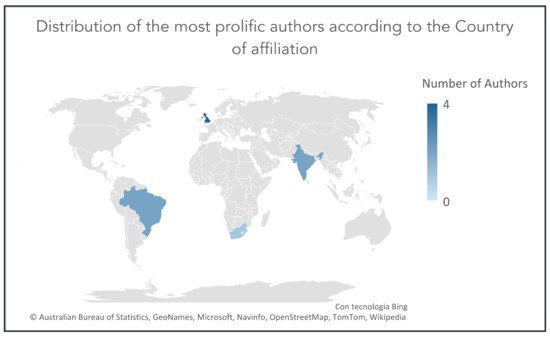
2.2. Analysis of Bibliographic Information
As for the impact of the contributions, the highest GCS were 183 [17], 99 [16][18] and 94 [19]. The average GCS was about 21, and 89% of contributions received so far less than 50 citations. The GCS was divided by the number of years since publication to better appreciate the breakthrough literature. The highest scores were 146 [17], 33 [18] and 24 citations/year [20]. The average score was almost 7, and 79% of contributions received so far less than 10 citations/year. As the first ten contributions according to both the analyses were almost overlapping, the second analysis pinpoints the breakthrough potential of specific conceptual works [20][18] and particularly of the empirical ones by Yadav et al. [21] and Bag et al. [22] (Figure 4). However, numerous contributions from 2020 to 2021 received so far 0 citations, so the list of breakthrough contributions might change in a short time.
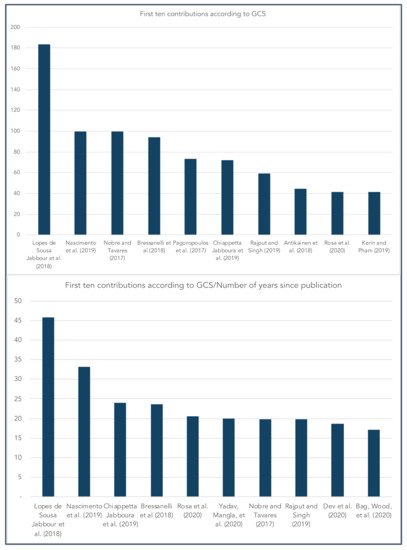
Figure 4. First ten contributions according to GCS and GCS/number of years after publication.
2.3. Analysis of Content
The most discussed CE aspects were related to CBM, SCM and DIGIT, while among the least discussed, REUSE and SMSER can be identified (Figure 5. Referring to the ReSOLVE areas, the main addressed ones were exchange and optimize, while among the least discussed, virtualize and share can be identified (Figure 5). As for DTs, the discourse was led by a general perspective on DTs. The most considered single DTs were IoT and DBA; nonetheless, the two of them were strongly interrelated, as IoT can be fully exploited only if the data collected are then processed with BDA [23] (Figure 6).
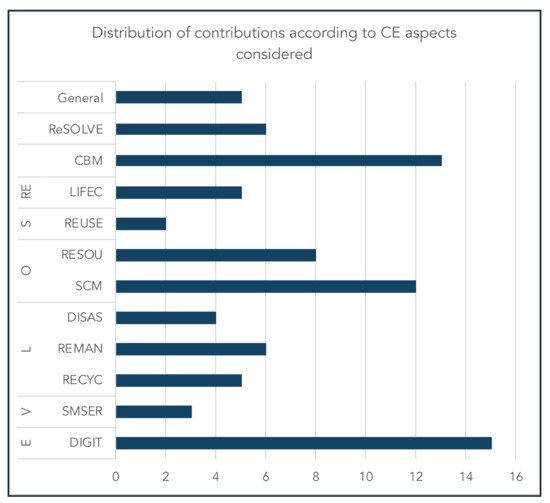

Figure 6. Distribution of the reviewed contributions according to DTs considered.
The integrated analysis of the two paradigms, considering how CE aspects and DTs have been integrated, offers sparks for further discussions (Figure 7): SCM was linked to the highest number of DTs and CYB particularly; DISAS and REMAN were linked with SIM and AR; DIGIT has been addressed from a general perspective in terms of DTs. Additionally, the literature has so far considered the impact of more DTs for the optimize and loop areas, compared to the other areas.
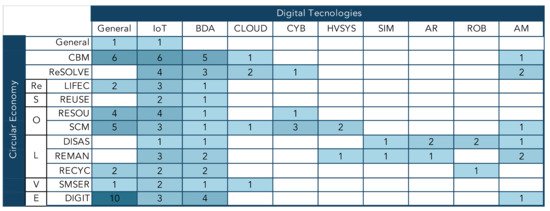
Figure 7. Heatmap of the distribution of the reviewed contributions according to CE aspects and DTs considered.
In terms of the type of study, 58% of contributions were theoretical, both review (n = 19) or conceptual papers (n = 20); the remaining share was either empirical (n = 18) or theoretical with a following empirical application (n = 9) (Figure 8).

Figure 8. Distribution of the reviewed contributions according to the type of study.
Focusing on the methodology for empirical application (Figure 9), 43% of the contributions (n = 12) employed the case study methodology, followed by surveys or expert opinions. Interestingly, none of the contributions conducted more than 10 case studies, as the majority conducted 1 (n = 6) or 3 (n = 3) case studies.
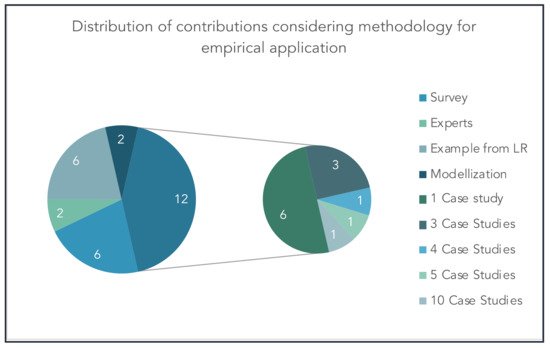
Figure 9. Distribution of the reviewed contributions according to the methodology employed for the empirical application.
2.4. Analysis of Context
Few contributions considered a specific context. In terms of geographical area, only 28% of contributions considered a specific one (n = 18), with a predominance of European countries (n = 14). As for the sector, 55% of contributions addressed a specific sector (n = 29), and most of them focused on the manufacturing sector in general. As for the size of firms, very few contributions considered a specific one, with 82% of contributions not providing any information. Some contributions nonetheless addressed specifically small and medium enterprises (SMEs) (n = 8), large enterprises (LEs) (n = 3) or both (n = 1).
References
- United Nations. Transforming Our World: The 2030 Agenda for Sustainable Development; 2015. Available online: (accessed on 4 March 2021).
- European Commission. The European Green Deal; 2019. Available online: (accessed on 4 March 2021).
- Dantas, T.E.T.; de-Souza, E.D.; Destro, I.R.; Hammes, G.; Rodriguez, C.M.T.; Soares, S.R. How the combination of Circular Economy and Industry 4.0 can contribute towards achieving the sustainable development goals. Sustain. Prod. Consum. 2021, 26, 213–227.
- Cioffi, R.; Travaglioni, M.; Piscitelli, G.; Petrillo, A.; Parmentola, A. Smart manufacturing systems and applied industrial technologies for a sustainable industry: A systematic literature review. Appl. Sci. 2020, 10, 2897.
- Alamerew, Y.A.; Brissaud, D. Circular economy assessment tool for end of life product recovery strategies. J. Remanuf. 2019, 9, 169–185.
- Kirchherr, J.; Reike, D.; Hekkert, M. Conceptualizing the circular economy: An analysis of 114 definitions. Resour. Conserv. Recycl. 2017, 127, 221–232.
- Helander, H.; Petit-Boix, A.; Leipold, S.; Bringezu, S. How to monitor environmental pressures of a circular economy: An assessment of indicators. J. Ind. Ecol. 2019, 23, 1278–1291.
- Fonseca, L.; Domingues, J.; Pereira, M.; Martins, F.; Zimon, D. Assessment of circular economy within portuguese organizations. Sustainability 2018, 10, 2521.
- Massaro, M.; Secinaro, S.; Dal Mas, F.; Brescia, V.; Calandra, D. Industry 4.0 and circular economy: An exploratory analysis of academic and practitioners’ perspectives. Bus. Strateg. Environ. 2021, 30, 1213–1231.
- Büchi, G.; Cugno, M.; Castagnoli, R. Smart factory performance and Industry 4.0. Technol. Forecast. Soc. Chang. 2020, 150, 119790.
- Ardito, L.; Petruzzelli, A.M.; Panniello, U.; Garavelli, A.C. Towards Industry 4.0: Mapping digital technologies for supply chain management-marketing integration. Bus. Process Manag. J. 2019, 25, 323–346.
- Chauhan, C.; Sharma, A.; Singh, A. A SAP-LAP linkages framework for integrating Industry 4.0 and circular economy. Benchmarking Int. J. 2019.
- Antikainen, M.; Uusitalo, T.; Kivikytö-Reponen, P. Digitalisation as an enabler of circular economy. Procedia CIRP 2018, 73, 45–49.
- Rüßmann, M.; Lorenz, M.; Gerbert, P.; Waldner, M.; Justus, J.; Engel, P.; Harnisch, M. Industry 4.0: The future of productivity and growth in manufacturing industries. BCG Perspect. 2015.
- Ghoreishi, M.; Happonen, A. New promises AI brings into circular economy accelerated product design: A review on supporting literature. E3S Web Conf. 2020, 158, 06002.
- Nobre, G.C.; Tavares, E. Scientific literature analysis on big data and internet of things applications on circular economy: A bibliometric study. Scientometrics 2017, 111, 463–492.
- Lopes de Sousa Jabbour, A.B.; Jabbour, C.J.C.; Godinho Filho, M.; Roubaud, D. Industry 4.0 and the circular economy: A proposed research agenda and original roadmap for sustainable operations. Ann. Oper. Res. 2018, 270, 273–286.
- Nascimento, D.L.M.; Alencastro, V.; Quelhas, O.L.G.; Caiado, R.G.G.; Garza-Reyes, J.A.; Lona, L.R.; Tortorella, G. Exploring Industry 4.0 technologies to enable circular economy practices in a manufacturing context: A business model proposal. J. Manuf. Technol. Manag. 2019, 30, 607–627.
- Bressanelli, G.; Adrodegari, F.; Perona, M.; Saccani, N. Exploring how usage-focused business models enable circular economy through digital technologies. Sustainability 2018, 10, 639.
- Chiappetta Jabbour, C.J.; Lopes de Sousa Jabbour, A.B.; Sarkis, J.; Filho, M.G. Unlocking the circular economy through new business models based on large-scale data: An integrative framework and research agenda. Technol. Forecast. Soc. Chang. 2019, 144, 546–552.
- Yadav, G.; Mangla, S.K.; Bhattacharya, A.; Luthra, S. Exploring indicators of circular economy adoption framework through a hybrid decision support approach. J. Clean. Prod. 2020, 277, 124186.
- Bag, S.; Wood, L.C.; Mangla, S.K.; Luthra, S. Procurement 4.0 and its implications on business process performance in a circular economy. Resour. Conserv. Recycl. 2020, 152, 104502.
- Erro-Garcés, A. Industry 4.0: Defining the research agenda. Benchmarking Int. J. 2019.




